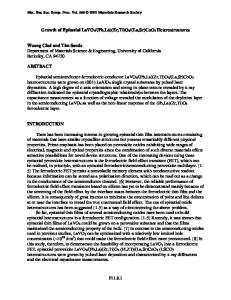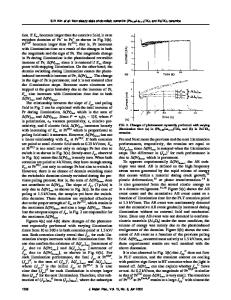Epitaxial Growth of LaVO 3 /(Ba, Sr)TiO 3 /(Pb, La)(Zr, Ti)O 3 /(La, Sr)CoO 3 Semiconductor/Ferroelectric/Conductor Hete
- PDF / 66,079 Bytes
- 6 Pages / 612 x 792 pts (letter) Page_size
- 72 Downloads / 364 Views
Epitaxial Growth of LaVO3/(Ba,Sr)TiO3/(Pb,La)(Zr,Ti)O3/(La,Sr)CoO3 Semiconductor/Ferroelectric/Conductor Heterostructures
Woong Choi and Tim Sands Department of Materials Science & Engineering, University of California, Berkeley, CA 94720 ABSTRACT The feasibility of using LaVO3 as a semiconducting layer in all-oxide semiconductor/ferroelectric/conductor heterostructures was explored by growing epitaxial LaVO3/(Ba,Sr)TiO3/(Pb,La)(Zr,Ti)O3/(La,Sr)CoO3 heterostructures on (001) LaAlO3 single crystal substrates by pulsed laser deposition. A high degree of c-axis orientation and strong inplane texture revealed by x-ray diffraction indicated the epitaxial crystallographic relationships between the layers. With a 30 nm layer of (Ba,Sr)TiO3, the heterostructure showed optimal ferroelectric hysteresis with remanent polarizations over 30 µC/cm2. The capacitance measurement as a function of voltage might reveal the modulation of the depletion layer in the semiconducting LaVO3.
INTRODUCTION It is now possible to grow complex epitaxial oxide thin film heterostructures consisting of materials that have similar crystalline structures but possess remarkably different physical properties. Prime emphasis has been placed on perovskite oxides exhibiting wide ranges of electrical, magnetic and optical properties since the combination of such diverse materials offers attractive possibilities for novel device structures. [1,2] One of the interesting devices using these epitaxial perovskite heterostructures is the ferroelectric field effect transistor (FET), which can be realized with an epitaxial ferroelectric/semiconducting perovskite multilayer. [3-8] The ferroelectric FET configuration permits a nonvolatile memory element with nondestructive readout; binary information can be stored as a polarization direction, the sign of which can be determined by the value of the conductance of the semiconductor channel. [9] However, the reliable performance of ferroelectric field effect transistors based on silicon has yet to be demonstrated, mainly because of the screening of the field effect by the interface states between the ferroelectric thin film and the silicon. It is consequently of great interest to minimize the concentration of point and line defects at or near the interface to reveal the true unscreened field effect. The use of epitaxial oxide heterostructures has been suggested [3-8] as a way of circumventing the above problem. So far, epitaxial thin films of several semiconducting oxides such as (La,Sr)2CuO4 and (La,Ca)MnO3 have been used by previous researchers to build epitaxial heterostructures in a ferroelectric FET configuration. [3-8] However, the relatively high carrier concentration in these heavily doped or degenerate semiconducting oxides is likely to be the main reason that ferroelectric field effects in these structures have been smaller than desired for a nonvolatile binary memory device. LaVO3 is also a semiconducting oxide, but unlike those used by previous researchers, it can be synthesized with a relatively low ioniz
Data Loading...










